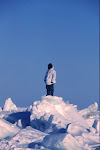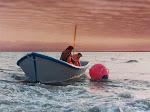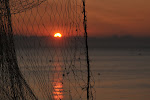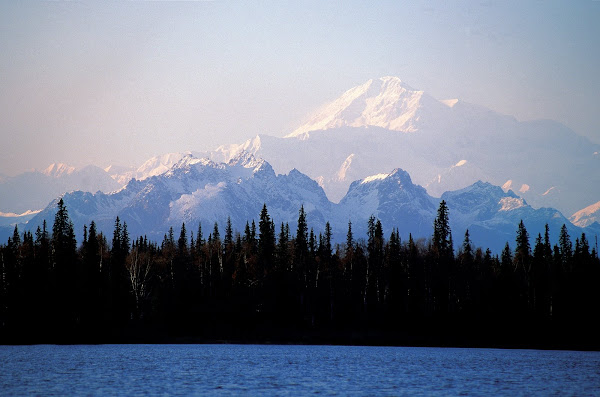During the winter of 1988, not long after I moved to Kodiak, the police scanner went off in the newsroom, broadcasting a report of a dead body in an abandoned house. One of the other reporters went out to investigate and returned a little while later chuckling to herself.
“It was a raven,” she announced.
“A dead raven?” I asked.
“No,” she said. “The raven wasn’t dead, it was on the roof.”
The blank look on my face betrayed my confusion, so before I could respond, Nell explained that an old woman who lived near the house had noticed a raven perched on the roof. And as she explained to the police, “everyone knows a raven on the roof means someone has died there, or will soon.”
There was no body in the house and we laughed about it then, but sometime later that year a grader scraped a skull out of the road near that house. It turned out to be very old, and was thought to come from a Russian-era cemetery, long forgotten but marked on old maps. Probably a coincidence, but the old lady’s story still crossed my mind.
I hadn’t thought of the incident until the other night when I was walking out to the shed on an unusually quiet evening. No road noise, no lawnmowers thrumming in the distance, even the sled dogs lounged on their boxes staring at me in eerie silence.
By chance, I glanced up into the treetops and saw six or seven ravens in the branches above the shed. They were dark blotches against a darkening sky, so I’d be lying if I said I could see their black eyes following me, but it sure felt like it. I instinctively glanced at the roof of the house and felt oddly relieved that no black bird was perched there.
Back inside, I mentioned the ravens to my wife and she said she had noticed them also, and found them disconcerting. My 9-year-old daughter overheard us and piped in, “Yeah, I saw them too,” she said. “They’re freaking me out.” That about summed it up for all of us.
When I went to bed that night I had a hard time falling to sleep, I kept thinking about the old lady’s superstition, and listening for the sound of bird feet scrabbling on the roof tiles.
Wednesday, May 26, 2010
Friday, May 21, 2010
My junk, your stuff
ONE OF THE MORE tenacious Alaska cliches is that we're all pack rats. It is tenacious because there is more than a little truth behind it.
If you've traveled anywhere in Alaska, either remote or urban, you've probably seen plenty of homes surrounded with the discarded but notfully- disposed-of detritus of life here.
The practice of pack-ratting was more prevalent in days past, when lines of transit to and from the Lower 48 were less reliable. The farther out you lived, the more likely you were to hang onto that old truck or snowmobile or washing machine, just in case the new one failed.
A man who runs riverboats on the Yukon told me the story of a fellow captain who once lost power and drifted helplessly in the big river’s current until he spotted an abandoned truck on the bank. He secured the boat to a tree and attacked the old truck with his tool kit. When he returned to his vessel he carried an armload of harvested parts. Soon the riverboat’s engine coughed to life and he went on about his business.
Such stories once held a lot of sway in this state justifying our practice of moving things out of the house but not necessarily off the property.
Still, I used to shake my head whenever I saw a cluttered place, and wondered why people would live in such a beautiful setting and surround themselves with junk.
"I'll never become one of those guys," I thought to myself.
But this last weekend as I looked around the yard I realized that I might be slipping.
A 55-gallon burn barrel still rests next to the shed we built last fall. A wooden boat that hasn’t seen the ocean for two years is dry docked on the hill next to the house. A borrowed snowmobile rests on a trailer next to the old shed. Two retired dogsleds and a camper shell are peeking from a melting snow bank in front of the old truck, which, for the record, still runs.
The four-wheelers—one running, one not—are hidden under the deck.
I’m not sure how this happened.
But as I looked at each relic, I realized that my stuff is different. If I can get that dead four-wheeler running, I could probably get $500 for it. The boat will sail again, if only to our land on the other side of Kachemak Bay.
The snowmobile runs perfectly, I just have to get the brake lights working on the trailer before I can take it out on the road. The burn barrel may not be legal but, from where it sits, it can’t be seen from the road, so it can’t move. The camper shell will trade places with the dog box on the truck when summer comes. And the sleds, well, who could bring themselves to part with two weathered, rustic-looking dog sleds? My wife put plants on one last summer and it looked great.
I still don’t know why people would live in such a beautiful place and surround themselves with junk.
Surrounding one’s self with objects that are potentially lucrative, relatively attractive and may well be useful one day, well that’s another story.
If you've traveled anywhere in Alaska, either remote or urban, you've probably seen plenty of homes surrounded with the discarded but notfully- disposed-of detritus of life here.
The practice of pack-ratting was more prevalent in days past, when lines of transit to and from the Lower 48 were less reliable. The farther out you lived, the more likely you were to hang onto that old truck or snowmobile or washing machine, just in case the new one failed.
A man who runs riverboats on the Yukon told me the story of a fellow captain who once lost power and drifted helplessly in the big river’s current until he spotted an abandoned truck on the bank. He secured the boat to a tree and attacked the old truck with his tool kit. When he returned to his vessel he carried an armload of harvested parts. Soon the riverboat’s engine coughed to life and he went on about his business.
Such stories once held a lot of sway in this state justifying our practice of moving things out of the house but not necessarily off the property.
Still, I used to shake my head whenever I saw a cluttered place, and wondered why people would live in such a beautiful setting and surround themselves with junk.
"I'll never become one of those guys," I thought to myself.
But this last weekend as I looked around the yard I realized that I might be slipping.
A 55-gallon burn barrel still rests next to the shed we built last fall. A wooden boat that hasn’t seen the ocean for two years is dry docked on the hill next to the house. A borrowed snowmobile rests on a trailer next to the old shed. Two retired dogsleds and a camper shell are peeking from a melting snow bank in front of the old truck, which, for the record, still runs.
The four-wheelers—one running, one not—are hidden under the deck.
I’m not sure how this happened.
But as I looked at each relic, I realized that my stuff is different. If I can get that dead four-wheeler running, I could probably get $500 for it. The boat will sail again, if only to our land on the other side of Kachemak Bay.
The snowmobile runs perfectly, I just have to get the brake lights working on the trailer before I can take it out on the road. The burn barrel may not be legal but, from where it sits, it can’t be seen from the road, so it can’t move. The camper shell will trade places with the dog box on the truck when summer comes. And the sleds, well, who could bring themselves to part with two weathered, rustic-looking dog sleds? My wife put plants on one last summer and it looked great.
I still don’t know why people would live in such a beautiful place and surround themselves with junk.
Surrounding one’s self with objects that are potentially lucrative, relatively attractive and may well be useful one day, well that’s another story.
Saturday, April 17, 2010
Cool no more
Used to be, no matter where in the world you travelled, if you identified yourself as an Alaskan you immediately acquired a tangible aura of coolness that could get you at the least a good conversation, and at best free drinks and an audience. Even calling an 800 number used to yield a 50-50 chance of changing a routine business exchange to a Q and A on all things Alaska and a reminder of what is unique about living here. "What is the temperature there now?" "How long does the sun stay up in the sky?" "There's a moose in your yard!?"
Now, though, no one seems to care about the midnight sun or big salmon. They don't ask questions about moose or igloos. Instead, they just want to know all about Sarah Palin.
She is the most famous Alaskan on the planet. No Alaskan, past or present, is as well known as her, and that is not likely to change anytime soon. Love her or hate her—and those seem to be the only two options from which people choose—she personifies the quintessential Alaskan to the rest of world.
Now the 800 number ordeal promises to be mind-numbing with the added bonus of questions like, "Do you know Sarah Palin?" "Is she really as pretty as she looks on TV?" "Don't you love her?"
I usually point out that she hasn't been much seen in these parts since she bailed out of the governor's seat and headed south to make her millions. Getting any more critical than that is dangerous because her fans and detractors are equally vehement and angering someone who has your credit card number is never a good idea.
If you think I'm exaggerating, consider the experience of my friend, Tom Devine. He was in Nepal, last year, supporting a party attempting to summit Everest. When word got around that he was from Alaska, a Nepalese Sherpa approached him and asked if he knew Sarah Palin. Around the same time, Tim Woody, Alaska’s editor, was traveling in a remote part of New Zealand when his car broke down. While he was trying to get it restarted a man emerged from a nearby farmhouse and offered his help. When Tim told him he was from Alaska, the man asked, “So, are ya friends with Sarah?” Kes Woodward, an internationally-known Alaskan painter, told me about a similar experience during art show in Germany.
So from down under to high on the Himalayan Plateau and in fancy German art galleries to boot, people think Alaskans wink and say "you betcha" and are radically conservative. I've been here for 47 years, I don't wink and I've neither used the phrase "you betcha" nor heard anyone but her say it. The rightwing leaning? Well there is more than a little truth to that. Alaska, long a Democratic bastion, moved to the right with the development of oil more than 30 years ago and has stayed there, for the most part, ever since. Keep in mind, though, one of our U.S. senators is a Democrat and we've regularly ignored party lines to vote for individuals who would best represent us.
While Sarah Palin was wildly popular among Alaska voters at the time of her election, she is not so well liked now. Maybe it's jealousy over her success, feelings of abandonment or disdain toward her apparent lack of humility regarding the opportunity that John McCain handed to her. Whatever the reason, I doubt she'd experience the political success she found here just a few years ago if she returned to Alaska politics.
None of that matters though. Sarah Palin has become an international figure and we're left in her wake, fielding inane questions about her and wishing desperately that we could regain the coolness we once enjoyed. I used to get mad when I encountered people who thought Alaska was part of Canada or worse, that it is a country of its own. Now I miss those simpler times.
Alaska is more than the place where Sarah Palin came from but convincing the world of that will be difficult, if not impossible.
Now, though, no one seems to care about the midnight sun or big salmon. They don't ask questions about moose or igloos. Instead, they just want to know all about Sarah Palin.
She is the most famous Alaskan on the planet. No Alaskan, past or present, is as well known as her, and that is not likely to change anytime soon. Love her or hate her—and those seem to be the only two options from which people choose—she personifies the quintessential Alaskan to the rest of world.
Now the 800 number ordeal promises to be mind-numbing with the added bonus of questions like, "Do you know Sarah Palin?" "Is she really as pretty as she looks on TV?" "Don't you love her?"
I usually point out that she hasn't been much seen in these parts since she bailed out of the governor's seat and headed south to make her millions. Getting any more critical than that is dangerous because her fans and detractors are equally vehement and angering someone who has your credit card number is never a good idea.
If you think I'm exaggerating, consider the experience of my friend, Tom Devine. He was in Nepal, last year, supporting a party attempting to summit Everest. When word got around that he was from Alaska, a Nepalese Sherpa approached him and asked if he knew Sarah Palin. Around the same time, Tim Woody, Alaska’s editor, was traveling in a remote part of New Zealand when his car broke down. While he was trying to get it restarted a man emerged from a nearby farmhouse and offered his help. When Tim told him he was from Alaska, the man asked, “So, are ya friends with Sarah?” Kes Woodward, an internationally-known Alaskan painter, told me about a similar experience during art show in Germany.
So from down under to high on the Himalayan Plateau and in fancy German art galleries to boot, people think Alaskans wink and say "you betcha" and are radically conservative. I've been here for 47 years, I don't wink and I've neither used the phrase "you betcha" nor heard anyone but her say it. The rightwing leaning? Well there is more than a little truth to that. Alaska, long a Democratic bastion, moved to the right with the development of oil more than 30 years ago and has stayed there, for the most part, ever since. Keep in mind, though, one of our U.S. senators is a Democrat and we've regularly ignored party lines to vote for individuals who would best represent us.
While Sarah Palin was wildly popular among Alaska voters at the time of her election, she is not so well liked now. Maybe it's jealousy over her success, feelings of abandonment or disdain toward her apparent lack of humility regarding the opportunity that John McCain handed to her. Whatever the reason, I doubt she'd experience the political success she found here just a few years ago if she returned to Alaska politics.
None of that matters though. Sarah Palin has become an international figure and we're left in her wake, fielding inane questions about her and wishing desperately that we could regain the coolness we once enjoyed. I used to get mad when I encountered people who thought Alaska was part of Canada or worse, that it is a country of its own. Now I miss those simpler times.
Alaska is more than the place where Sarah Palin came from but convincing the world of that will be difficult, if not impossible.
Tuesday, March 30, 2010
Morning
I know a mountain is in front of me only because of what I can’t see. It is a moonless morning and in the place where the peak should be is a black, crag-shaped hole in the heavens, empty of the white points of starlight that puncture the plumb-colored sky behind it. One light moves in the void though, it’s my partner Charlie’s headlamp, dipping and bobbing as he makes his way up the trail ahead of me.
The temperature is in the upper 20s and the snow is old and crusty, perfect for kicking in steps. Our progress is slow but steady; he’ll be at the top in 20 minutes, I’ll be there in 25.
On the summit, the wind finds its way into my jacket and chills my sweaty skin. To the east the sky is brightening over a series of peaks that seem to go on forever. It’s easy to imagine I’m deep in the heart of a remote mountain range, but I only have to turn around to see the truth, that I’m within a few miles of half the population of Alaska. Below, rolling west toward the sea is a carpet of city lights and, if I listen closely, the faint sound of automobile traffic and a barking dog rises to my ear.
Then the wind comes up, the sounds of the city die away and I turn my back to face the rising sun. Like the walls of a great fortress, the peaks of the Chugach Range separate Anchorage from a close and very real wilderness. These mountains are home to wolves, moose, Dall sheep and bear—both black and brown, among other wild creatures. And there are rocky spires, glaciers, high lakes and hanging valleys that beckon further exploration.
Not today though: Charlie and I turn and begin to descend. In a half an hour we’ll be at our cars and soon after, under the fluorescent lights of our respective offices. Not a pleasant prospect, but tolerable given the way we started our day.
The temperature is in the upper 20s and the snow is old and crusty, perfect for kicking in steps. Our progress is slow but steady; he’ll be at the top in 20 minutes, I’ll be there in 25.
On the summit, the wind finds its way into my jacket and chills my sweaty skin. To the east the sky is brightening over a series of peaks that seem to go on forever. It’s easy to imagine I’m deep in the heart of a remote mountain range, but I only have to turn around to see the truth, that I’m within a few miles of half the population of Alaska. Below, rolling west toward the sea is a carpet of city lights and, if I listen closely, the faint sound of automobile traffic and a barking dog rises to my ear.
Then the wind comes up, the sounds of the city die away and I turn my back to face the rising sun. Like the walls of a great fortress, the peaks of the Chugach Range separate Anchorage from a close and very real wilderness. These mountains are home to wolves, moose, Dall sheep and bear—both black and brown, among other wild creatures. And there are rocky spires, glaciers, high lakes and hanging valleys that beckon further exploration.
Not today though: Charlie and I turn and begin to descend. In a half an hour we’ll be at our cars and soon after, under the fluorescent lights of our respective offices. Not a pleasant prospect, but tolerable given the way we started our day.
Sunday, December 6, 2009
Warming tent

My wife is filling in as editor of the Alaska Star and so I've been tapped to provide photos on occasion. I was attending the Eagle River tree-lighting ceremony last Friday, shooting kids with Santa, grumpy reindeer handlers and angelic-voiced kids singing carols. As the evening wound down, the 15 degree F. temperature started getting the better of some of the families so they started migrating toward the warming tent. I saw some interesting silhouettes so I walked over andy pointed my camera at the wall and waited. The shadows waivered, unrecognizable shapes twisted and stretched across the wall, then this father and child walked into the tent and scooted in along the wall. The shadow was just what I had hoped and I shot it with my D300 and a 24 mm zoom. I had to flash it, but kept the power dialed back to about -1.7.
Sunday, November 29, 2009
Starting over
I was skiing earlier this evening on the ski trails near my house and wondered if slogging around the same trail system year after year might be a sign of insanity, or dementia at least. The temperature was 20 degrees, just about perfect for skate skiing and I had the trails to myself. I've skied since I was a kid, mostly around the Anchorage bowl and for the last ten years on the Chugiak ski trails just north of Eagle River.
I was skating up a hill when I flashed back to a similar night several years ago when I was cruising the trails with a friend, walking the hills and stopping at the top of each to catch our breaths. Now, a decade older, it seems like I can cover the whole trail system in the time it used to take me to go 10 kilometers. I'm not sure if I'm in better shape or if my expectations have diminished enough to intersect with my athletic ability. I suspect the latter.
I was skating up a hill when I flashed back to a similar night several years ago when I was cruising the trails with a friend, walking the hills and stopping at the top of each to catch our breaths. Now, a decade older, it seems like I can cover the whole trail system in the time it used to take me to go 10 kilometers. I'm not sure if I'm in better shape or if my expectations have diminished enough to intersect with my athletic ability. I suspect the latter.
Subscribe to:
Posts (Atom)





